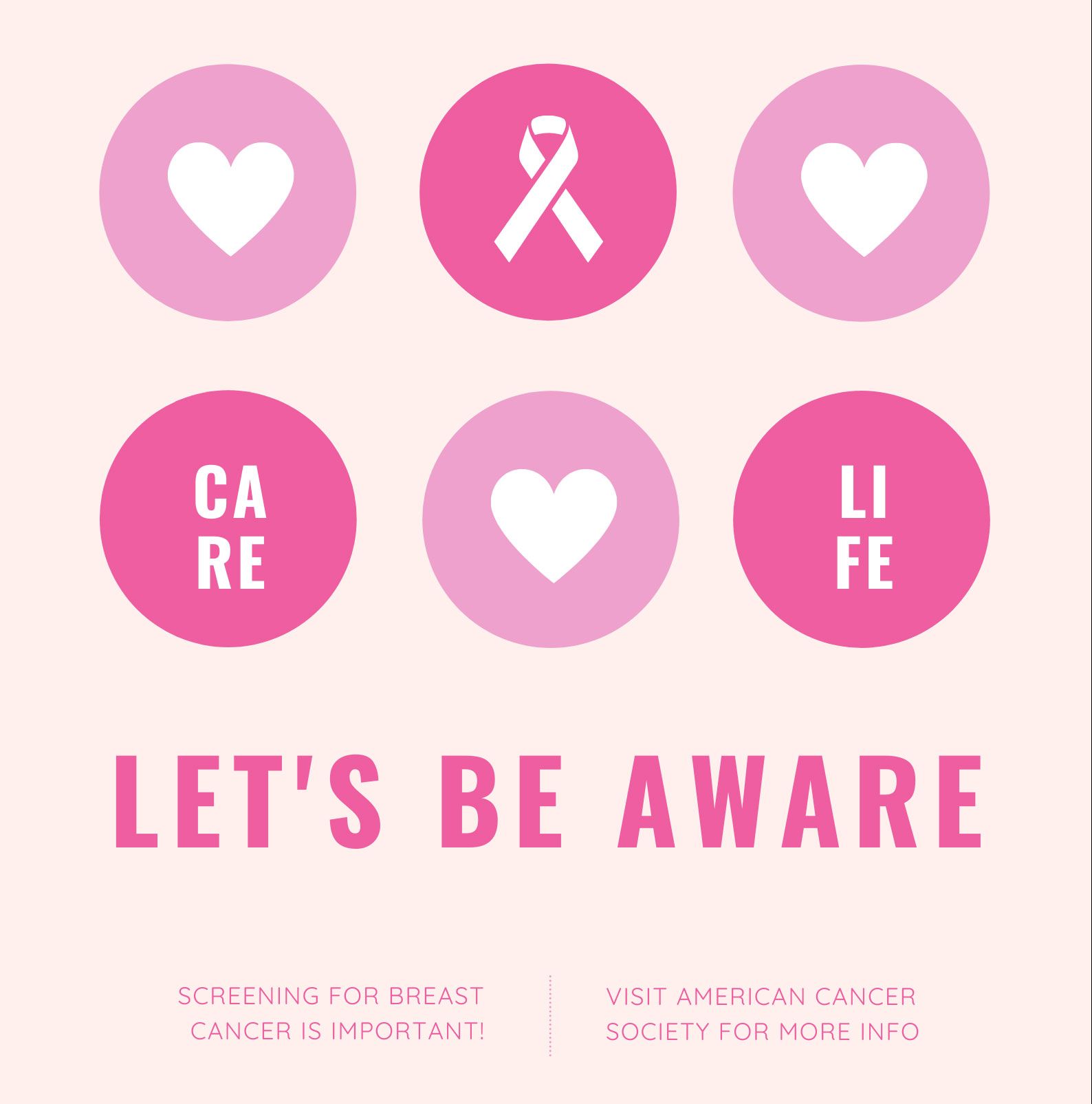ACCEPTING NEW PATIENTS
Breast Cancer Awareness

Breast cancer is an uncontrolled growth of breast cells. The term breast cancer refers to a malignant tumor that has developed from cells in the breast. Usually, breast cancer begins in the cells of the lobules, which are the milk-producing glands; or the ducts, the passages that drain milk from the lobules to the nipple. Less commonly, breast cancer can begin in the stromal tissues, which include the fatty and fibrous connective tissues of the breast.
Symptoms
Breast cancer may not initially cause symptoms, which is why screening is so important. However, the following unusual changes in the breast can be a symptom of breast cancer: American Cancer Society
- Swelling of all or part of the breast
- Skin irritation or dimpling
- Breast pain
- Nipple pain or the nipple turning inward
- Redness, scaliness, or thickening of the nipple or breast skin
- Nipple discharge other than breast milk
- Lump in the underarm area
Breast self-exam should be part of your monthly health care routine. Most breast lumps are not cancer, but visit your doctor for further evaluation if you experience breast changes. If you’re over 40 or at a high risk of breast cancer, you should also have an annual mammogram and physical exam by a doctor.
Risk Factors You Can Control
- Weight: Being overweight is associated with an increased risk of breast cancer, especially for women after menopause. Fat tissue is the body’s main source of estrogen after menopause when the ovaries stop producing the hormone.
- Exercise and Diet: Evidence is growing that exercise can reduce breast cancer risk. The American Cancer Society recommends engaging in 45-60 minutes of physical exercise 5 or more days a week.
- Alcohol Consumption: Studies have shown that breast cancer risk increases with the amount of alcohol a woman drinks. Alcohol can limit your liver’s ability to control blood levels of the hormone estrogen, which in turn can increase risk.
- Smoking: Smoking is associated with an increase in breast cancer risk.
- Exposure to estrogen: Because the female hormone estrogen stimulates breast cell growth, exposure to estrogen over a long period of time, without any breaks, can increase the risk of breast cancer. For example: Taking combined hormone replacement therapy (estrogen and progesterone; HRT) for several years, or taking estrogen alone for more than 10 years.
Risk Factors You Cannot Control
- Gender: Being a woman is the most significant risk factor for developing breast cancer. Although men can get breast cancer too, women’s breast cells are constantly changing and growing, mainly due to female hormones estrogen and progesterone. This activity puts them at a much greater risk for breast cancer.
- Age: Simply growing older is the second greatest risk factor for breast cancer. From age 30 to 39, the risk is 1 in 228 or 0.44%. That jumps to 1 in 29, or just under 3.5%, by the time you are in your 60s.
- Family history of breast cancer: If you have a first-degree relative (mother, daughter, or sister) who has had breast cancer. Or you have multiple relatives affected by breast or ovarian cancer (especially before they turned 50), you could be at higher risk of getting breast cancer.
- Personal history of breast cancer: If you have already been diagnosed with breast cancer, your risk of developing it again, either in the same breast or the other breast, is higher than if you never had the disease.
- Race: White women are slightly more likely to develop breast cancer than are black women. However, black women are likely to develop more aggressive, advanced-stage breast cancer that is diagnosed at a young age. Asian, Hispanic, and Native American women have a lower risk of developing and dying from breast cancer.
- Radiation therapy to the chest: Radiation therapy to the chest area as a child or young adult, typically as a treatment for another cancer significantly increases breast cancer risk.
Over 80% of people with breast cancer do not have a family history of breast cancer as a result, screening for breast cancer is important. Be sure to talk with your doctor about your risk factors for breast cancer. There may be steps you can take to lower your risk, and your doctor can help you come up with a plan.
Be sure to contact your doctor in regards to screening. Screening tests (such as yearly mammograms) are given routinely to people who appear to be healthy. The purpose is to find breast cancer early so that it is easier to treat.

At InTouch Primary Care, we have a personalized approach to preventive health. We take the time to assess your risks and work closely with you.
Our patients do not have to switch doctors because of insurance changes.
Our patients have easy access to care, so we can promptly address their concerns.
To become a patient, click on Schedule Now, and we will be in touch. You can also Contact Us if you would like more information. Share if you found this helpful.
Phone: (713) 280-9985
Email: info@intouchprimarycare.com
Address: 2333 Town Center Dr, Sugar Land, TX 77478, United States of America
- Mon - Thu
- -
- Fri - Sun
- Closed
- Mon - Thu
- -
- Fri - Sun
- Closed
